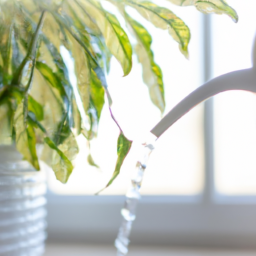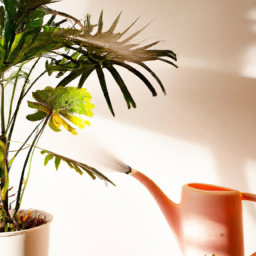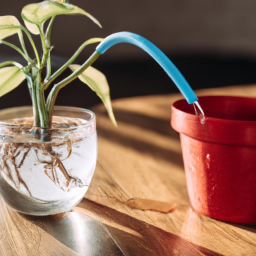
Hey there plant lovers! Have you ever wondered, “Should indoor plants be watered everyday?” Well, you’re not alone. Many plant enthusiasts debate the frequency of watering indoor plants, and it’s a topic that has sparked quite a bit of discussion. Some argue that daily watering is necessary for optimal plant health, while others believe it can do more harm than good. In this blog post, we’ll dive into the pros and cons of watering indoor plants every day, so you can make an informed decision for your leafy companions. So, grab your favorite plant and let’s get started!
The Importance of Proper Watering for Indoor Plants
Indoor plants not only add beauty to our living spaces but also provide numerous benefits, such as purifying the air and reducing stress levels. However, to ensure their optimal growth and longevity, it is crucial to understand the importance of proper watering. In this article, we will delve into the reasons why watering indoor plants correctly is essential and provide you with a step-by-step guide to help you determine whether your indoor plants should be watered every day.
Understanding the Watering Needs of Indoor Plants
1.1 Water as a Vital Element
Water plays a crucial role in the life of indoor plants. Just like any other living organism, plants require water for their survival. It serves as a medium for transporting nutrients from the soil to different parts of the plant, helps in the process of photosynthesis, and maintains turgidity, which is essential for structural support. Therefore, providing adequate water to your indoor plants is vital for their overall health and well-being.
1.2 Factors Affecting Watering Frequency
The watering needs of indoor plants can vary depending on several factors. These factors include the type of plant, its stage of growth, the size of the pot, the type of potting mix, humidity levels, temperature, and the amount of light it receives. Understanding these factors will help you determine the appropriate watering frequency for your indoor plants.
1.3 Signs of Underwatering and Overwatering
It is crucial to be able to identify signs of both underwatering and overwatering in your indoor plants. Underwatering may lead to wilting, dry soil, and yellowing or browning of leaves. On the other hand, overwatering can result in root rot, fungus gnats, mold growth, and yellowing or drooping leaves. By paying attention to these signs, you can adjust your watering routine accordingly and prevent potential damage to your plants.
Determining the Watering Frequency for Indoor Plants
2.1 Observe the Soil Moisture Level
One of the best ways to determine whether your indoor plants need watering is by observing the moisture level of the soil. Insert your finger about an inch deep into the soil. If it feels dry, it is an indication that your plant requires watering. However, if the soil feels moist, it is better to hold off on watering to avoid overwatering.
2.2 Consider the Plant’s Watering Preferences
Each indoor plant has its own watering preferences. Some plants, such as succulents and cacti, prefer drier conditions and can tolerate longer periods between watering. On the other hand, tropical plants or those with high water requirements may need more frequent watering. Researching the specific watering needs of your indoor plants will help you determine the appropriate watering frequency.
2.3 Assess Environmental Factors
Environmental factors, such as temperature, humidity, and light levels, can significantly impact the watering needs of indoor plants. Higher temperatures and lower humidity levels can cause the soil to dry out faster, requiring more frequent watering. Additionally, plants placed in bright, direct sunlight may need more water compared to those in lower light conditions. Consider these factors when determining the watering frequency for your indoor plants.
Establishing a Proper Watering Routine
3.1 Watering Techniques
When watering your indoor plants, it is important to use the right techniques to ensure proper absorption and distribution of water. Water the plants thoroughly until water starts to drain out of the bottom of the pot. This ensures that the entire root system receives adequate moisture. Avoid shallow watering, as it can lead to uneven moisture distribution and encourage shallow root growth.
3.2 Avoiding Waterlogged Soil
Overwatering can lead to waterlogged soil, which deprives the roots of oxygen and can cause root rot. To avoid this, make sure your pots have drainage holes to allow excess water to escape. If your pots do not have drainage holes, consider using a well-draining potting mix or adding a layer of gravel at the bottom of the pot to improve drainage.
3.3 Adjusting Watering Frequency
As mentioned earlier, the watering needs of indoor plants can change over time due to various factors. It is essential to regularly assess the moisture level of the soil and adjust your watering frequency accordingly. During the dormant season or winter months, when plants are not actively growing, they may require less water compared to the warmer months when they are actively growing.
Proper watering is crucial for the health and vitality of your indoor plants. By understanding the importance of providing adequate water, observing the soil moisture level, considering plant preferences, and adjusting watering frequency based on environmental factors, you can ensure the optimal growth and longevity of your indoor plants. Remember, each plant is unique, so it is essential to research and understand the specific watering needs of your indoor plants to provide them with the care they require.

Should Indoor Plants Be Watered Everyday?
As an expert in indoor gardening, I understand the importance of providing the right amount of water to indoor plants. Watering is a crucial aspect of plant care, but the frequency of watering can vary depending on several factors. In this article, we will delve into the question of whether indoor plants should be watered every day and explore the factors that should be considered when determining the watering schedule.
Factors to Consider When Watering Indoor Plants Daily
1. Plant Type and Size:
One of the primary factors to consider when deciding on the frequency of watering is the type and size of the indoor plant. Different plants have different water requirements, and their size also plays a role in determining how much water they need. Larger plants generally require more water compared to smaller ones. It is essential to research the specific needs of your indoor plants to provide them with the appropriate amount of water.
Moreover, certain plant species are more tolerant of drought conditions and can go longer periods without water. Succulents, for example, have adapted to store water in their leaves and stems, making them more resistant to dry conditions. On the other hand, tropical plants with thin leaves and high transpiration rates may require more frequent watering.
2. Environmental Conditions:
The environment in which your indoor plants are placed significantly affects their water needs. Factors such as temperature, humidity, and air circulation play a vital role in determining the rate of water evaporation from the soil and plant surfaces.
In warmer and drier environments, plants tend to lose moisture more quickly, necessitating more frequent watering. On the contrary, in cooler and more humid conditions, plants may require less frequent watering. It is essential to monitor the environmental conditions around your indoor plants and adjust the watering schedule accordingly.
3. Soil Type and Drainage:
The type of soil and its drainage capacity also influence the watering frequency. Well-draining soil allows excess water to flow out, preventing waterlogging and root rot. On the other hand, poorly draining soil retains water for longer periods, increasing the risk of overwatering.
If your indoor plants are potted in soil that retains moisture for an extended period, it is crucial to be cautious with watering. In such cases, daily watering can lead to waterlogged soil and root suffocation. Conversely, plants in well-draining soil may require more frequent watering to ensure they receive adequate moisture.
4. Plant Growth Stage:
The growth stage of your indoor plants also plays a role in determining their water requirements. Newly potted plants or those in the early stages of growth may have smaller root systems and may need more frequent watering to establish themselves.
As the plants mature and develop a more extensive root network, their water needs may decrease. It is essential to adjust the watering frequency as your plants grow to avoid over or underwatering.
Conclusion
When it comes to watering indoor plants daily, several factors need to be considered. The type and size of the plant, environmental conditions, soil type, and plant growth stage all play a crucial role in determining the appropriate watering schedule.
It is important to research the specific needs of your indoor plants and monitor their response to watering to ensure they receive the right amount of moisture. Overwatering can lead to root rot and other issues, while underwatering can cause dehydration and stunted growth.
Remember, each plant is unique, and finding the right watering routine may require some trial and error. By paying attention to the factors discussed in this article and staying attuned to your plant’s needs, you can ensure that your indoor plants thrive and flourish.

Pros and Cons of Watering Indoor Plants Everyday
Indoor plants add beauty and freshness to any space, but when it comes to watering them, there is often confusion about the right frequency. Some people believe that watering indoor plants every day is essential for their health, while others argue that it can lead to overwatering and root rot. In this article, we will explore the pros and cons of watering indoor plants every day, helping you make an informed decision for your green companions.
The Pros of Watering Indoor Plants Everyday
1. Adequate Moisture: Watering your indoor plants every day ensures that they receive a consistent supply of moisture. This is particularly important for plants that prefer moist soil, such as ferns or tropical plants. Regular watering can help prevent the soil from drying out too much between watering sessions, providing a stable environment for your plants to thrive.
2. Prevents Underwatering: Indoor plants that are not watered enough can suffer from dehydration, resulting in wilted leaves, stunted growth, and even plant death. By watering your plants every day, you minimize the risk of underwatering and ensure that they have access to the necessary water for their survival.
3. Promotes Growth: Water is a vital component for plant growth. When you water your indoor plants daily, you provide them with the hydration they need to support their metabolic processes, nutrient absorption, and overall development. This can result in healthier, more vibrant plants with lush foliage.
The Cons of Watering Indoor Plants Everyday
1. Risk of Overwatering: One of the main concerns with watering indoor plants every day is the potential for overwatering. Overwatering can suffocate the roots, leading to root rot, fungal diseases, and ultimately plant death. It is crucial to strike a balance and ensure that the plants have enough time to dry out between watering sessions.
2. Lack of Oxygen: Overwatering can also lead to a lack of oxygen in the soil, as the excess water fills up the air pockets. Plant roots require oxygen to function properly, and without it, they can suffocate and deteriorate. By watering your indoor plants every day, you may inadvertently deprive them of the oxygen they need for healthy growth.
3. Dependent on Plant Species: Not all indoor plants have the same watering requirements. Some plants, like succulents and cacti, prefer drier conditions and can tolerate longer periods without water. On the other hand, plants that thrive in moist environments, such as ferns or peace lilies, may benefit from more frequent watering. It is crucial to consider the specific needs of your plants before deciding on a watering routine.
4. Time and Effort: Watering your indoor plants every day can be time-consuming, especially if you have a large collection or a busy schedule. It requires dedication and consistency to ensure that each plant receives the necessary amount of water. If you find it challenging to commit to daily watering, you may consider alternative watering methods, such as self-watering systems or using moisture meters to gauge the moisture levels in the soil.
In conclusion, whether or not you should water your indoor plants every day depends on various factors, including the plant species, environmental conditions, and your personal schedule. While daily watering can provide consistent moisture and promote growth, it also carries the risk of overwatering and root rot. It is essential to strike a balance and monitor the moisture levels of your plants to ensure their health and well-being. Remember to consider the specific needs of each plant and adjust your watering routine accordingly. Happy gardening!
Here’s what we learned
When it comes to indoor plants, one of the most common questions is how often they should be watered. Many plant owners wonder if watering them every day is necessary or if it can do more harm than good. Well, the answer isn’t as simple as a yes or no. It depends on various factors, such as the type of plant, its size, the environment it’s in, and even the season.
Firstly, it’s essential to understand that not all indoor plants have the same water requirements. Some plants, like succulents and cacti, are adapted to arid conditions and have the ability to store water in their leaves or stems. These types of plants generally thrive in well-draining soil and should be watered sparingly, allowing the soil to dry out completely between waterings. On the other hand, tropical plants with larger leaves, such as ferns or peace lilies, prefer consistently moist soil and may need to be watered more frequently.
Additionally, factors like the size of the plant and the environment it’s in can influence its water needs. Larger plants with more extensive root systems generally require more water, while smaller plants may need less frequent watering. The humidity levels in your home also play a role. If you live in a dry climate or have central heating, your plants may need more frequent watering to compensate for the lack of moisture in the air.
Lastly, it’s crucial to consider the season when determining how often to water indoor plants. During the warmer months, when plants are actively growing, they may require more water. However, in the cooler months, when growth slows down, watering frequency should be reduced to prevent overwatering and root rot.
In conclusion, there isn’t a one-size-fits-all answer to the question of whether indoor plants should be watered every day. It’s important to consider the specific needs of each plant, its size, the environment it’s in, and the season. Observing your plants closely and checking the moisture level of the soil will help you determine the right watering schedule. Remember, it’s always better to underwater than overwater, as most indoor plants are more tolerant of dry conditions than excessive moisture.
Your Questions Answered. Comprehensive FAQ:
Q1: Should indoor plants be watered every day?
A1: It depends on the specific needs of your indoor plants. While some indoor plants may require daily watering, most do not. Overwatering can actually harm your plants by causing root rot and other issues. It is important to understand the watering requirements of each plant species and adjust your watering schedule accordingly.
Q2: How often should I water my indoor plants?
A2: The frequency of watering indoor plants varies depending on various factors such as the type of plant, its size, the potting mix, and the environmental conditions. As a general guideline, it is best to allow the top inch or so of the soil to dry out before watering again. This usually translates to watering every 1-2 weeks, but it’s always a good idea to check the moisture level of the soil using your finger or a moisture meter.
Q3: What signs indicate that my indoor plants need water?
A3: Several signs can indicate that your indoor plants need water. These include drooping or wilting leaves, dry soil that has pulled away from the sides of the pot, and a lighter weight when you lift the pot. Additionally, some plants have specific indicators like leaves turning yellow or brown at the edges. Regularly monitoring your plants’ appearance and checking the soil moisture level will help you determine when it’s time to water.
Q4: Can I water my indoor plants from the bottom?
A4: Yes, you can water your indoor plants from the bottom by using the method known as bottom watering. To do this, place your plant’s pot in a tray or saucer filled with water and allow the soil to absorb the moisture from the bottom. This method can be particularly useful for plants with sensitive leaves that may be damaged by getting wet. However, it’s essential to ensure that the plant is not sitting in water for extended periods, as it can lead to root rot.
Q5: Are there any other factors to consider when watering indoor plants?
A5: Yes, besides the frequency of watering, it’s important to consider other factors. These include the type of pot and potting mix you use, the humidity levels in your home, and the amount of light your plants receive. Different pots and potting mixes can affect drainage and water retention, while low humidity and excessive light can increase water evaporation. Understanding these factors and adjusting your watering routine accordingly will help ensure the health and well-being of your indoor plants.

James Wong is a renowned ethnobotanist, plant scientist, and local television presenter. With a passion for demystifying plant science, he is known for translating complex botanical concepts into practical advice for everyday plant enthusiasts. James’s expertise spans from traditional gardening to cutting-edge plant technologies, making his insights accessible and informative.


